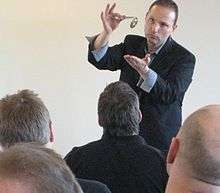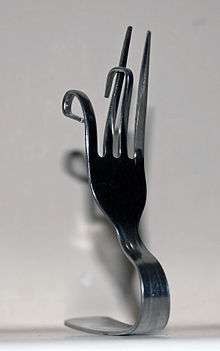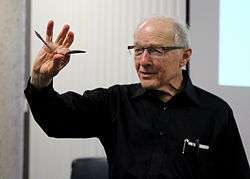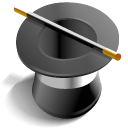Spoon bending
Spoon bending is the apparent deformation of objects, especially metal cutlery, either without physical force, or with less force than would normally seem necessary. It is a common form of stage magic, and a variety of methods are used to produce the illusion.

Spoon bending attracted considerable media attention in the 1970s when some people claimed to have the ability to cause such events by paranormal psychic means. The most notable was Uri Geller, who performed by bending metal spoons as well as metal keys and several other objects and materials. Geller's performances were attributed to stage magic by critics such as James Randi[1] and Martin Gardner.[2]
Stage magic

Causing spoons, keys, and other items to appear to bend without any physical force is a common stage magic trick that has many variants. Simply holding a spoon by its neck and rapidly tilting it back and forth can create the illusion that the spoon is bending, due to the way that the human eye perceives the rocking motion.[3]
When a spoon is physically bent or broken, it is usually at the point where the object would be easiest to bend by hand. In many cases, the trick uses misdirection, a basic tool of the stage magician. The performer draws the audience's attention away from the spoon during the brief moment while the spoon is being physically bent. The typical bend, where the bowl meets the handle, requires relatively little force. The magician then gradually reveals the bend.[4] When a 1996 BBC television show staged a prank on Uri Geller, it took footage from angles he was not expecting, which showed Geller grasping a spoon firmly with both hands as he stood up to display a bend in it.[5]

Other methods use a metal spoon that has been prepared so that a simple flick will cause it to bend or break. This can be done, for instance, by repeatedly bending the spoon at the desired spot, until the metal cracks and weakens. If the spoon breaks, the magician holds together the two halves of the spoon as if it were unbroken, then slowly relaxes the grip, making the spoon appear to bend before splitting in two.[6]
If a magician has control over the viewing angle, the trick can be done by using a spoon that is already bent at the start of the trick. The spoon is initially held with the bend along the viewing angle, making it invisible. The magician then turns the spoon slowly to reveal the bend. The magician Ben Harris, author of the book Gellerism Revealed: The Psychology and Methodology Behind the Geller Effect (1985), revealed step-by-step photographs and text showing how to bend keys and cutlery by trick methods.[7]
Some novelty or magic shops sell self-bending spoons (utilizing the physical properties of a nickel titanium alloy) which can be used by amateur and stage magicians to demonstrate "psychic" powers or as a practical joke. Such "self-bending" spoons will bend themselves when used to stir tea, coffee, or any other warm liquid, or even when warmed by body heat.
Psychology
In an experimental study (Wiseman and Greening, 2005) two groups of participants were shown a videotape in which a fake psychic placed a bent key on a table. Participants in the first group heard the fake psychic suggest that the key was continuing to bend when it had remained stationary, while those in the second group did not. The results revealed that participants from the first group reported significantly more movement of the key than the second group.
The findings were replicated in another study. The experiments had demonstrated that "testimony for PKMB [psychokinetic metal bending] after effects can be created by verbal suggestion, and therefore the testimony from individuals who have observed allegedly genuine demonstrations of such effects should not be seen as strong evidence in support of the paranormal".[8]
Spoon bending and the paranormal
Owing partly to the publicity surrounding Uri Geller in the 1970s, bent spoons have become a common visual symbol of the paranormal. It is shown, for example, in The Matrix, when a young boy bends a spoon to demonstrate the unreality of a computer simulation. Kadabra and Alakazam, fictional telechinetic characters from the Pokémon franchise, can be permanently seen holding bent spoons.
While many individuals have claimed the paranormal or psychokinetic ability to bend spoons or manipulate other objects, spoon bending by mental powers alone has not been demonstrated to the satisfaction of the scientific community. Magician and skeptic James Randi has offered a prize of one million dollars to any person who is able to demonstrate paranormal abilities such as spoon bending.[9]
Claims
From 1981 to 2005, (retired) Boeing Engineer Jack Houck[10] hosted "PK Parties" (psychokinesis parties) which he claims are a research project studying how the mind might impact metal. He is notable due to claiming to have documented over 19,000 participants. He claims that this phenomenon can be learned, and accomplished. He claims that skeptics can mentally block or negatively influence results.
Author Michael Crichton described his successful experience with spoon bending at a psychokinesis party in his 1988 book Travels:
I looked down. My spoon had begun to bend. I hadn't even realized. The metal was completely pliable, like soft plastic. It wasn't particularly hot, either, just slightly warm. ... I had bent a spoon, and I knew it wasn't a trick. I looked around the room and saw little children, eight or nine years old, bending large metal bars. They weren't trying to trick anybody.
— Michael Crichton, Travels, 1988, pages 319–320
Parapsychologist and author Dean Radin has reported that he was able to bend (buckle) the bowl of a spoon over with unexplained ease of force with witnesses present at an informal psychokinesis experiment gathering in 2000.
I was much more skeptical about such claims until one day I personally folded the bowl of a large, heavy soup spoon in half with a gentle touch, and with half a dozen witnesses present. I later tested to see if I could do this again with a similar spoon using ordinary force. I couldn't budge the bowl without the assistance of two pairs of pliers and some serious leverage.
— Dean Radin, Entangled Minds, page 331
Maureen Caudill, a trainer associated with the Monroe Institute, claims this is significantly easier to achieve when performed in groups rather than alone.[11]
Tests
Physicist John Hasted believed that children could paranormally bend paper clips inside a glass sphere, provided the sphere had a hole in it and they were allowed to take the sphere into a room unobserved. Martin Gardner wrote Hasted was incapable of devising simple controls such as videotaping the children secretly.[12] Stephen North, a British psychic, was tested by Hasted in the late 1970s. Hasted claimed North had the psychokinetic ability to bend spoons and teleport objects in and out of sealed containers.[13] North was tested in Grenoble on 19 December 1977 in scientific conditions and the results were negative.[14] According to James Randi, during a test at Birkbeck College, North was observed to have bent a metal sample with his bare hands. Randi wrote that "I find it unfortunate that [Hasted] never had an epiphany in which he was able to recognize just how thoughtless, cruel, and predatory were the acts perpetrated on him by fakers who took advantage of his naivety and trust."[15]
Jean-Pierre Girard, a French psychic, has claimed he can bend metal bars by psychokinesis. Girard was tested in the 1970s but failed to produce any paranormal effects in scientifically controlled conditions.[16] He was tested on January 19, 1977 during a two-hour experiment in a Paris laboratory. The experiment was directed by physicist Yves Farge with a magician also present. All of the experiments were negative as Girard failed to make any of the objects move paranormally. He failed two tests in Grenoble in June 1977 with James Randi.[16] He was also tested on September 24, 1977 at a laboratory at the Nuclear Research Centre. Girard failed to bend any bars or change the structure of the metals. Other experiments into spoon bending were also negative and witnesses described his feats as fraudulent. Girard later admitted that he would sometimes cheat to avoid disappointing the public but insisted he still had genuine psychic power.[16] Magicians and scientists have written that he produced all his alleged psychokinetic feats through fraudulent means.[17]
Between 1979 and 1981, the McDonnell Laboratory for Psychical Research at Washington University reported a series of experiments they named Project Alpha, in which two teenaged male subjects had demonstrated psychokinesis phenomena, including metal-bending and causing images to appear on film, under less than stringent laboratory conditions. James Randi eventually revealed that the subjects were two of his associates, amateur conjurers Steve Shaw and Michael Edwards. The pair had created the effects by standard trickery, but the researchers, being unfamiliar with magic techniques, interpreted them as proof of psychokinesis.[18]
John Taylor had tested children in metal bending. According to Martin Gardner, the controls were inadequate as the children would put paper clips in their pockets and later take one out twisted or be left with metal rods unobserved. James Randi managed to bend an aluminum bar when Taylor was not looking and scratch on it "Bent by Randi". In other experiments, two scientists from the University of Bath examined metal bending with children in a room which was secretly being videotaped through a one-way mirror. The film revealed that the children bent the objects with their hands and feet. Due to the evidence of trickery, Taylor concluded metal bending had no paranormal basis.[2]
See also
- Bent Spoon Award
- Psychokinesis
References
- Randi, James. (1982). The Truth About Uri Geller. Prometheus Books. ISBN 0-87975-199-1
- Gardner, Martin. (1983). Science: Good, Bad and Bogus. Oxford University Press. pp. 179-184. ISBN 0-19-286037-2
- Benedict Carey (August 11, 2008). "While a Magician Works, the Mind Does the Tricks". The New York Times.
- Emery, C. Eugene, Jr. (1987). "Catching Geller in the Act". The Providence Sunday Journal. Archived from the original (Reprint, hosted by permission) on 2011-07-16. Retrieved 2007-05-30.
- "James Randi exposes Uri Geller". YouTube. Retrieved 2010-07-27. Excerpt from "James Randi's Solved Mysteries Workshop", a talk given by Randi during the 1998 Skeptics Society Convention.
- Randi, James (October 19, 1993). Secrets of the Psychics (Documentary). NOVA. Event occurs at 5:15.
Of course, it does take a little preparation. In fact, it takes a lot of preparation... Isn't this a more reasonable explanation?
|access-date=requires|url=(help) - Harris, Ben. (1985). Gellerism Revealed: The Psychology and Methodology Behind the Geller Effect. Calgary: Micky Hades International.
- Wiseman, Richard; Greening, Emma. (2005). It's still bending': verbal suggestion and alleged psychokinetic ability. British Journal of Psychology 96: 115–127.
- "Skeptic Revamps $1M Psychic Prize". Wired. Retrieved June 18, 2008
- "PK Parties". Jack Houck. 1988. Retrieved April 25, 2017.
- Caudill, Maureen. (2006). Suddenly Psychic: A Skeptic's Journey. Chapter 7. ISBN 978-1-57174-501-9
- Gardner, Martin. (1991). The New Age: Notes of a Fringe-Watcher. Prometheus Books. pp. 28-29. ISBN 0-87975-644-6
- Hasted, John. (1981). The Metal-Benders. Routledge & Kegan Paul. ISBN 0-7100-0597-0
- Blanc, Marcel. (1978). "Fading Spoon Bender". New Scientist. p. 431.
- Randi, James. (1982). Chapter Off the Deep End in Flim-Flam! Psychics, ESP, Unicorns, and Other Delusions. Prometheus Books. ISBN 0-87975-198-3
- Information, Reed Business (1978-02-16). New Scientist - Google Books. Retrieved 2014-03-11.
- Zusne, Leonard; Jones, Warren. (1989). Anomalistic Psychology: A Study of Magical Thinking. Lawrence Erlbaum Associates. ISBN 0-8058-0508-7
- Colman, Andrew (1987). Facts, Fallacies and Frauds in Psychology. Unwin Hyman. pp. 195–6. ISBN 978-0-09-173041-3.
Further reading
- Henry Gordon. (1988). Extrasensory Deception: ESP, Psychics, Shirley MacLaine, Ghosts, UFOs. Macmillan of Canada. ISBN 0-7715-9539-5
- Ben Harris. (1985). Gellerism Revealed: The Psychology and Methodology Behind the Geller Effect. Calgary: Micky Hades International.
- Terence Hines. (2003). Pseudoscience and the Paranormal. Prometheus Books. ISBN 1-57392-979-4
- David Marks. (2000). The Psychology of the Psychic (2nd Edition). Prometheus Books. ISBN 1-57392-798-8
- Joe Nickell. (2013). Mind Over Metal. Skeptical Inquirer.
- James Randi. (1982). Flim-Flam! Psychics, ESP, Unicorns, and Other Delusions. Prometheus Books. ISBN 0-87975-198-3
External links
- Spoon-bending for beginners: Teaching anomalistic psychology to teenagers by Chris French.
- Uri Geller Caught Red-Handed by Massimo Polidoro.
- PK (spoon-bending) Party: format and materials by Jack Houck 1982
